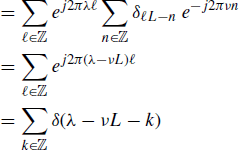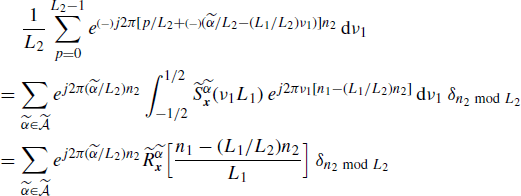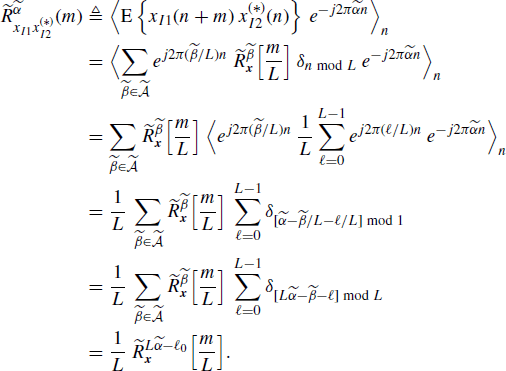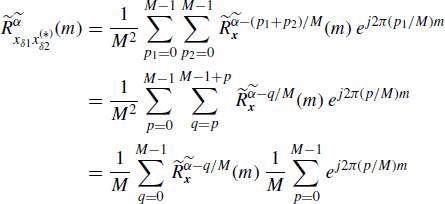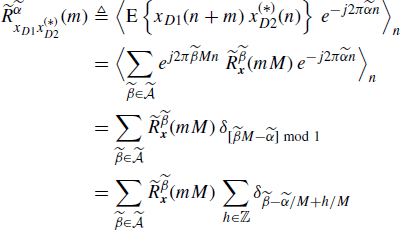5.11 Proofs for Section 4.10 “Multirate Processing of Discrete-Time Jointly SC Processes”
In this section, proofs of results of Section 4.10 are reported.
For future reference, let us consider the discrete-time sample train with sampling period M, its discrete Fourier series (DFS), and its Fourier transform:
where δm is the Kronecker delta, that is, δm = 1 if m = 0 and δm = 0 if m ≠ 0 and mod M denotes modulo operation with values in {0, 1, …, M − 1}. Thus, δn mod M = 1 if n = kM for some integer k and δn mod M = 0 otherwise.
Furthermore, in the sequel, the following identities are used
In the following proofs, the bounded variation assumption (4.192) allows to use the Fubini and Tonelli theorem (Champeney 1990, Chapter 3) to interchange the order of the integrals in ν1 and ν2.
5.11.1 Expansion (Section 4.10.1): Proof of (4.241), (4.242b), and (4.242c)
From the identity
(5.193) 
it follows that the impulse-response function of the LTV system that operates expansion is
(5.194) 
Thus, the transmission function is

where in the last equality the Poisson's sum formula (Zemanian 1987, p. 189)
is used. Equation (4.242b) follows by using the definition (4.243) of ![]() , where equalities should be intended in the sense of distributions (generalized functions) (Zemanian 1987).
, where equalities should be intended in the sense of distributions (generalized functions) (Zemanian 1987).
From (5.195), using the scaling property of the Dirac's delta δ(bt) = δ(t)/|b| (Zemanian 1987, p. 27) we have
(5.197) 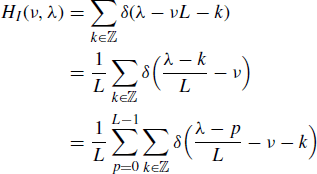
from which (4.242c) follows accounting for the definition of ![]() .
.
5.11.2 Expansion (Section 4.10.1): Proof of (4.250)
The inverse double Fourier transform of both sides of (4.248c) provides the cross-correlation of xI1(n) and xI2(n) (see (4.182) and (4.187))
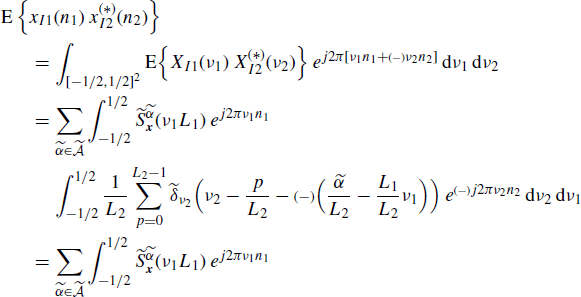
The third equality in (5.198) follows from the Fourier pair
(5.199) ![]()
and the fourth equality is due to (5.190). The fifth equality in (5.198) is a consequence of the Fourier-transform pair (4.244)–(4.245).
By substituting n1 = n + m and n2 = n into (5.198), (4.250) immediately follows.
5.11.3 Expansion (Section 4.10.1): Proof of (4.253)
From (4.250) with L1 = L2 = L and using (5.190) it follows that
The sixth equality of (5.200) follows observing that for every ![]() there is at most one value of
there is at most one value of ![]() , say
, say ![]() 0 (depending on
0 (depending on ![]() ,
, ![]() , and L), such that
, and L), such that ![]() , provided that
, provided that ![]() . In fact, it results that
. In fact, it results that
(5.201) 
Thus, (4.253) immediately follows since ![]() is periodic in
is periodic in ![]() with period 1.
with period 1.
5.11.4 Sampling (Section 4.10.2): Proof of (4.261)
Let be M1 = M2 = M. Each process xδi(n) is the product of the almost-cyclostationary discrete-time process xi(n) and the (real-valued) periodic train δn mod M with Fourier series expansion given in (5.190). Thus, by using the discrete-time counterpart of (1.143) or (Napolitano 1995, eq. (46)) (specialized to 2 single-input single-output systems, second-order, and reduced-dimension) we have
from which, accounting for (5.190), one obtains (4.261).
In (5.202), in the second equality the variable changes p = p1 and q = p1 + p2 are made and in the third equality the fact that ![]() is periodic in
is periodic in ![]() with period 1 is used, so that the sum over
with period 1 is used, so that the sum over ![]() can be equivalently extended over
can be equivalently extended over ![]() .
.
5.11.5 Decimation (Section 4.10.3): Proof of (4.268), (4.269b), and (4.269c)
From the identity
(5.203) 
it follows that the impulse-response function of the LTV system that operates decimation is
(5.204) 
Consequently, the transmission function is
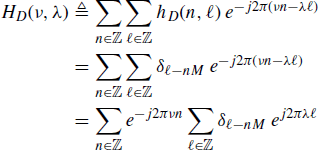
where in the last equality the Poisson's sum formula (5.196) is used. Equation (4.269b) follows by the definition of ![]() . From (5.205), using the scaling property of the Dirac delta, we have
. From (5.205), using the scaling property of the Dirac delta, we have
(5.206) 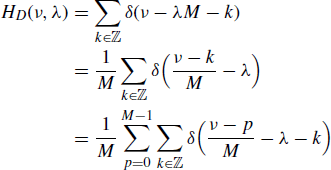
from which (4.269c) follows accounting for the definition of ![]() .
.
5.11.6 Decimation (Section 4.10.3): Proof of (4.277)
By using (4.275) we have
(5.207) 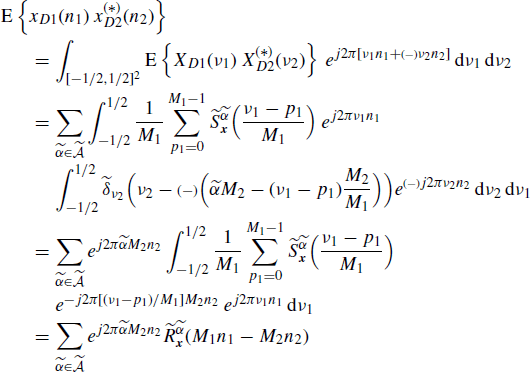
where, in the fourth equality, the Fourier-transform pairs (see (4.270) and (4.272))
(5.208) ![]()
(5.209) 
are accounted for.
Equation (4.277) follows by substituting n1 = n + m and n2 = n.
5.11.7 Decimation (Section 4.10.3): Proof of (4.278)
From (4.277) with M1 = M2 = M it follows that
In the rhs of (5.210), there are at most M (consecutive) values of h such that ![]() since when
since when ![]() ranges in
ranges in ![]() it results that
it results that ![]() . Therefore, (4.278) follows, accounting for the periodicity in
. Therefore, (4.278) follows, accounting for the periodicity in ![]() with period 1 of
with period 1 of ![]() .
.
5.11.8 Expansion and Decimation (Section 4.10.4): Proof of (4.286)
Accounting for (4.182) and (4.187) and using (4.285) and the sampling property of the Dirac delta, the cross-correlation function of xI1(n) and xD2(n) can be expressed as
(5.211) 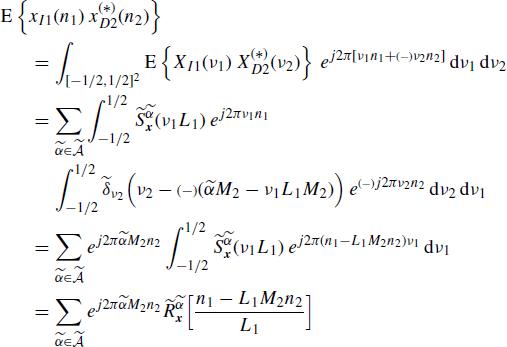
where, in the last equality, the Fourier-transform pair (4.244) and (4.245) is used. By substituting n1 = n + m and n2 = n we have (4.286).
5.11.9 Strictly Band-Limited SC Processes (Section 4.9.1): Proof of (4.287a)–(4.288b)
Let x1(n) and x2(n) be strictly band-limited processes with bandwidths B1 and B2, respectively. It results that
If x1(n) and x2(n) are jointly SC with Loève bifrequency cross-spectrum (4.190a), then (5.212) specializes into
Let us define the sets
(5.214) 
(5.215) 
Analogously to the continuous-time case, without lack of generality the functions ![]() and
and ![]() in (4.190a) and (4.190b) can be chosen with supports such that the sets
in (4.190a) and (4.190b) can be chosen with supports such that the sets ![]() and
and ![]() are at most countable (Definition 4.2.4 and Theorem 4.2.7). In addition, let us assume that the number of cluster points (accumulation points) of
are at most countable (Definition 4.2.4 and Theorem 4.2.7). In addition, let us assume that the number of cluster points (accumulation points) of ![]() and
and ![]() is at most finite. Thus, from (5.213) it follows that
is at most finite. Thus, from (5.213) it follows that ![]()
where ![]() and
and ![]() , with cl{ · } denoting set closure. From (5.216) it follows that
, with cl{ · } denoting set closure. From (5.216) it follows that
almost everywhere for ν1 ![]() [− 1/2, 1/2). However, since
[− 1/2, 1/2). However, since ![]() is at most countable, the cross-correlation (4.198a) is not modified assuming that (5.217) holds everywhere. Thus, (4.287a) and (4.287b) immediately follow.
is at most countable, the cross-correlation (4.198a) is not modified assuming that (5.217) holds everywhere. Thus, (4.287a) and (4.287b) immediately follow.
Analogously, starting from (4.190b), the band-limitedness condition (5.212) leads to
(5.218) ![]()
from which (4.288a) and (4.288b) follow.
5.11.10 Interpolation Filters (Section 4.10.6): Proof of the Image-Free Sufficient Condition (4.290)
Accounting for (4.246a), (4.287a), and (4.287b), the support of each term in the sum over ![]() in (4.289) is given by
in (4.289) is given by
(5.219) 
where
Let ![]() be the Fourier transform of
be the Fourier transform of ![]() . It results that
. It results that
(5.221) ![]()
where
(5.222) ![]()
The following conditions are sufficient to assure that the Loève bifrequency cross-spectrum ![]() in (4.289) is a frequency-scaled image-free version of
in (4.289) is a frequency-scaled image-free version of ![]() :
:
(5.223) ![]()
(5.224) ![]()
(5.225) ![]()
(5.226) ![]()
The sufficient conditions in items 1–4 can be summarized into the sufficient condition (4.290).
5.11.11 Interpolation Filters (Section 4.10.6): Proof of the Sufficient Conditions (4.291) and (4.292)
Let us assume that (4.290) holds. Thus the Loève bifrequency cross-spectrum ![]() in (4.289) is a frequency-scaled image-free version of
in (4.289) is a frequency-scaled image-free version of ![]() with
with ![]() given by (4.246a)–(4.246c). In addition, form (4.290) and B1 ≤ 1/2 it follows that
given by (4.246a)–(4.246c). In addition, form (4.290) and B1 ≤ 1/2 it follows that
For a fixed ![]() , due to condition (4.291), it results that
, due to condition (4.291), it results that
If both conditions (5.227) and (5.228) are satisfied, then in expression (4.246b) of the Loève bifrequency cross-spectrum ![]() , for ν1
, for ν1 ![]() [− 1/(2L1), 1/(2L1)] the support curve
[− 1/(2L1), 1/(2L1)] the support curve ![]() of the replica with h = 0 can intersect other support curves with the same k (h ≠ 0) only if on these other curves the spectral correlation density is zero. In fact, 1/L1 − B1/L1 is the smallest |ν1| in correspondence of which the image around ν1 = ± 1/L1 of the replica centered in ν2 = 0 (h = 0 in (4.246b)) can have nonzero spectral correlation density. Moreover, 1/L2 − B2/L2 is the smallest |ν2| in correspondence of which the image around ν1 = 0 of the replica centered in ν2 = ± 1/L2 (h = ± 1 in (4.246b)) can have nonzero spectral correlation density. Thus, the density of Loève bifrequency cross-spectrum (4.289) along the considered support curve is a frequency-scaled image-free version of the corresponding density of Loève bifrequency cross-spectrum
of the replica with h = 0 can intersect other support curves with the same k (h ≠ 0) only if on these other curves the spectral correlation density is zero. In fact, 1/L1 − B1/L1 is the smallest |ν1| in correspondence of which the image around ν1 = ± 1/L1 of the replica centered in ν2 = 0 (h = 0 in (4.246b)) can have nonzero spectral correlation density. Moreover, 1/L2 − B2/L2 is the smallest |ν2| in correspondence of which the image around ν1 = 0 of the replica centered in ν2 = ± 1/L2 (h = ± 1 in (4.246b)) can have nonzero spectral correlation density. Thus, the density of Loève bifrequency cross-spectrum (4.289) along the considered support curve is a frequency-scaled image-free version of the corresponding density of Loève bifrequency cross-spectrum ![]() ∀ν1
∀ν1 ![]() [− 1/(2L1), 1/(2L1)].
[− 1/(2L1), 1/(2L1)].
Condition (5.228) holding for every ![]() jointly with B2 ≤ 1/2 gives
jointly with B2 ≤ 1/2 gives
(5.229) ![]()
(5.230) ![]()
which prove sufficiency of (4.291).
The proof of sufficiency of (4.292) is similar.
5.11.12 Decimation Filters (Section 4.10.7): Proof of the Aliasing-Free Sufficient Condition (4.293)
The Loève bifrequency cross-spectrum of xD1(n) and xD2(n) is given by (4.273a)–(4.273c). Accounting for (4.287a) and (4.287b), the support of each term in the sums over k, p1, and p2 in (4.273a) is given by
(5.231) 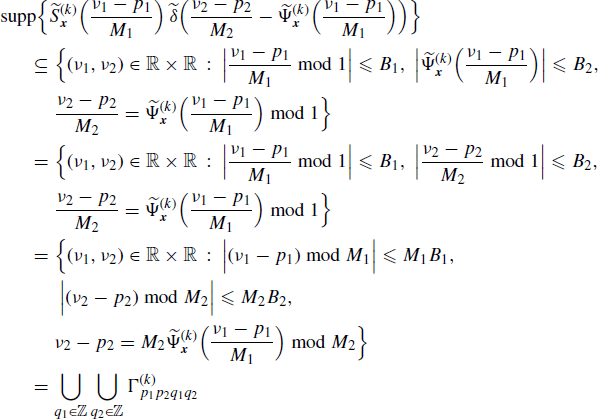
where
(5.232) 
with pi ![]() {0, 1, …, Mi − 1} and
{0, 1, …, Mi − 1} and ![]() , (i = 1, 2).
, (i = 1, 2).
If MiBi ≤ 1/2, (i = 1, 2), then
(5.233) ![]()
for every k and k′ in ![]() (possibly k = k′). Therefore, (4.293) is a sufficient condition to assure that the Loève bifrequency cross-spectrum
(possibly k = k′). Therefore, (4.293) is a sufficient condition to assure that the Loève bifrequency cross-spectrum ![]() is a frequency-scaled alias-free version of
is a frequency-scaled alias-free version of ![]() .
.
5.11.13 Decimation Filters (Section 4.10.7): Proof of the Sufficient Conditions (4.294) and (4.295)
Let us assume that condition (4.293) holds. Thus, the Loève bifrequency cross-spectrum ![]() in (4.273a)–(4.273c) is a frequency-scaled alias-free version of
in (4.273a)–(4.273c) is a frequency-scaled alias-free version of ![]() . From (4.293) it immediately follows that
. From (4.293) it immediately follows that
For a fixed ![]() , due to condition (4.294) one obtains
, due to condition (4.294) one obtains
If conditions (5.234) and (5.235) are both verified, then in expression (4.273b) of the Loève bifrequency cross-spectrum ![]() , for ν1
, for ν1 ![]() [− 1/2, 1/2] the support curve
[− 1/2, 1/2] the support curve ![]() of the replica with h = 0, p1 = 0 can intersect other support curves with the same k (h ≠ 0, p1 ≠ 0) only if on these other curves the spectral correlation density is zero. In fact, 1 − M1B1 is the smallest |ν1| in correspondence of which replicas with p1 = ± 1 can have nonzero spectral correlation density and 1 − M2B2 is the smallest |ν2| in correspondence of which replicas with h = ± 1 can have nonzero spectral correlation density. Thus, the density of Loève bifrequency cross-spectrum (4.273b) along the considered support curve is a frequency-scaled alias-free version of the corresponding density of Loève bifrequency cross-spectrum
of the replica with h = 0, p1 = 0 can intersect other support curves with the same k (h ≠ 0, p1 ≠ 0) only if on these other curves the spectral correlation density is zero. In fact, 1 − M1B1 is the smallest |ν1| in correspondence of which replicas with p1 = ± 1 can have nonzero spectral correlation density and 1 − M2B2 is the smallest |ν2| in correspondence of which replicas with h = ± 1 can have nonzero spectral correlation density. Thus, the density of Loève bifrequency cross-spectrum (4.273b) along the considered support curve is a frequency-scaled alias-free version of the corresponding density of Loève bifrequency cross-spectrum ![]() for every ν1
for every ν1 ![]() [− 1/2, 1/2].
[− 1/2, 1/2].
Condition (5.235) holding for every ![]() jointly with B2 ≤ 1/(2M2) prove sufficiency of (4.294).
jointly with B2 ≤ 1/(2M2) prove sufficiency of (4.294).
The proof of sufficiency of (4.295) is similar.
5.11.14 Fractional Sampling Rate Converters (Section 4.10.8): Proof of (4.296)
It results that

where, in the first and third equality, (4.272) and (4.245) are accounted for, respectively. By using (4.190a) into (5.236), (4.296) immediately follows.




